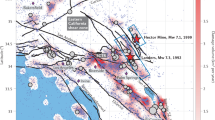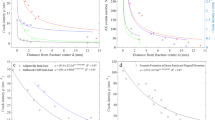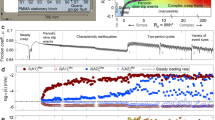Abstract
IN the past twenty years it has become commonplace in seismology to sum seismic moments for large earthquakes to determine the contemporary fault slip rate1 or regional strain rate produced by earthquakes2. The method has several drawbacks: it often greatly underestimates deformation rates predicted from plate tectonics, either because the seismic history is of insufficient length or a substantial amount of fault slip is aseismic. Also, it can be used to calculate only current deformation rates, and cannot be applied to earlier geological eras or to estimate total strain. These problems can be overcome by applying the same methods to geological measures of fault displacement. Complete fault data sets, however, are generally not available. Here we show that faults obey general scaling laws in their size frequency distribution and in the relation between displacement and fault length. Combining these scaling relations, we demonstrate that the calculation of strain can be successfully applied to sparse geological data sets, because most strain is produced by the largest faults so that the data set need not be complete for small fault sizes.
This is a preview of subscription content, access via your institution
Access options
Subscribe to this journal
Receive 51 print issues and online access
$199.00 per year
only $3.90 per issue
Buy this article
- Purchase on Springer Link
- Instant access to full article PDF
Prices may be subject to local taxes which are calculated during checkout
Similar content being viewed by others
References
Brune, J. J. geophys. Res. 73, 777–784 (1968).
Kostrov, B. Izv. Acad. Sci. USSR Phys. Solid Earth. 1, 23–44 (1974).
Davies, G. & Brune, J. Nature (Phys. Sci.) 229, 101–107 (1971).
Molnar, P. Bull. seism. Soc. Am. 69, 115–134 (1979).
Sykes, L. & Quittmeyer, R. in Earthquake Prediction: an International Review M. Ewing Ser.4. (eds Simpson, D. & Richards, P.) 217–247 (American Geophysical Union, Washington, DC, 1981).
Jackson, J. & McKenzie, D. Geophys. J. R. astr. Soc. 93, 45–73 (1988).
Ekstrom, G. & England, P. J. geophys. Res. 94, 10231–10257 (1989).
Wesnousky, S., Scholz, C. & Shimazaki, K. J. geophys. Res. 87, 6829–6852 (1982).
Villemin, T. & Sunwoo, C. C. r. hebd., Acad. Séanc. Sci. Paris. Ser. 2 305, 1309–1311 (1987).
Hirata, T. Pure appl. Geophys. 131, 157–170 (1989).
Gudmundsson, A. Tectonophysics 139, 295–308 (1987).
Gudmundsson, A. J. struct. Geol. 9, 61–69 (1987).
Kakimi, T. Bull. geol. Soc. Jap. 31, 467–487 (1980).
Cowie, P. & Scholz, C. Eos 71, 631 (1990).
Scholz, C. Bull. seism. Soc. Am. 72, 1–14 (1982).
Watterson, J. Pure appl. Geophys. 124, 366–373 (1986).
Kautz, S. & Sclater, J. Tectonics 7, 823–832 (1988).
Marrett, R. & Allmendinger, R. Geol. Soc. Am., Abstr. Prog 20, A319 (1988).
Marrett, R. & Allmendinger, R. J. struct. Geol. (in the press).
Wesnousky, S. G. thesis, Columbia Univ. (1982).
Working Group for Active Faults in Japan Active Faults in Japan: Sheet maps and inventories (University of Tokyo Press, 1980).
Walsh, J. & Watterson, J. J. struct. Geol. 9, 1039–1046 (1987).
Muraoka, H. & Kamata, H. J. struct. Geol. 5, 483–495 (1983).
Elliott, D. Phil. Trans. R. Soc. A283, 289–312 (1976).
Ranalli, G. Tectonophysics 37, 1–7 (1977).
Opheim, J. & Gudmundsson, A. Geol. Soc. Am. Bull. 101, 1608–1622 (1989).
Author information
Authors and Affiliations
Rights and permissions
About this article
Cite this article
Scholz, C., Cowie, P. Determination of total strain from faulting using slip measurements. Nature 346, 837–839 (1990). https://doi.org/10.1038/346837a0
Received:
Accepted:
Issue Date:
DOI: https://doi.org/10.1038/346837a0
This article is cited by
-
Properties of fault zones and their influences on rainfall-induced landslides, examples from Alborz and Zagros ranges
Environmental Earth Sciences (2022)
-
Temporal and spatial earthquake clustering revealed through comparison of millennial strain-rates from 36Cl cosmogenic exposure dating and decadal GPS strain-rate
Scientific Reports (2021)
-
Effective hydraulic conductivity of discrete fracture network with aperture-length correlation
Geosciences Journal (2020)
-
Selection of Optimal Thresholds for Estimation and Simulation Based on Indicator Values of Highly Skewed Distributions of Ore Data
Natural Resources Research (2018)
-
2-D Density and Directional Analysis of Fault Systems in the Zagros Region (Iran) on a Regional Scale
Pure and Applied Geophysics (2018)
Comments
By submitting a comment you agree to abide by our Terms and Community Guidelines. If you find something abusive or that does not comply with our terms or guidelines please flag it as inappropriate.



